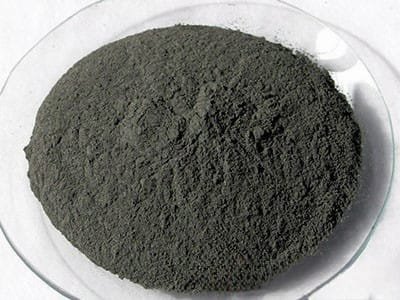Niobium Powder Overview
Niobium is a shiny, gray metal known for its ductility and paramagnetic properties. It shares similar chemical and oxidation resistance characteristics with tantalum. Niobium powder is a crucial component in various industries, including aerospace, medical, and electronics, where it is alloyed with iron or nickel.
Key Features of Niobium Powder
Physical Properties
- Appearance: Light gray powder
- Performance: Exceptional melting point and resistance to corrosion
Applications
- Alloy Additive: Enhances the properties of alloys
- Welding Electrodes: Integral in the production of welding electrodes
Approximately 90% of niobium powder is utilized in creating high-grade structural steel, with the remainder employed in the production of superalloys.
Niobium Powder for metallurgical purpose
| Grade | FNb-1 | FNb-2 | FNb-3 | FXNb-1 | FXNb-2 | FXNb-3 | |
|---|---|---|---|---|---|---|---|
| Nb+Ta,%,Minimum | – | – | 98 | – | – | – | |
| Impurity content ,%,max | Ta | 0.2 | 0.5 | – | 0.1 | 0.2 | 0.3 |
| O | 0.2 | 0.2 | 0.5 | 0.3 | 0.35 | 0.5 | |
| H | 0.005 | 0.005 | 0.01 | 0.005 | 0.01 | 0.01 | |
| N | 0.04 | 0.06 | – | 0.02 | 0.04 | 0.05 | |
| C | 0.05 | 0.05 | 0.08 | 0.02 | 0.04 | 0.04 | |
| Fe | 0.01 | 0.05 | – | 0.01 | 0.02 | 0.03 | |
| Si | 0.005 | 0.01 | – | 0.005 | 0.01 | 0.01 | |
| Ni | 0.005 | 0.005 | – | 0.005 | 0.01 | 0.01 | |
| Cr | 0.005 | – | – | 0.005 | 0.01 | 0.01 | |
| W | 0.005 | 0.01 | – | 0.005 | 0.01 | 0.01 | |
| Mo | 0.003 | 0.005 | – | 0.005 | 0.01 | 0.01 | |
| Ti | 0.003 | 0.005 | – | 0.005 | 0.01 | 0.01 | |
| Mn | 0.003 | 0.005 | – | 0.005 | 0.01 | 0.01 | |
| Cu | 0.003 | 0.005 | – | 0.003 | 0.006 | 0.006 | |
| Al | 0.003 | 0.006 | 0.006 | ||||
| P | – | – | 0.01 | – | – | – | |
| S | – | – | 0.01 | – | – | – | |
| Sieve mesh | -100mesh, -80mesh, -325meh | ||||||
| Re-inspected plus sieve powder shall be less than5% | |||||||
| Special requirements to be agreed upon by the supplier and buyer | |||||||
Spherical Niobium Powder
TFM’s spherical niobium metal powder is highly suitable for 3D printing applications. This powder can be used to create metal objects directly through Direct Metal Laser Sintering (DMLS), a common 3D printing technique known for its precision and high-density output.
Benefits of TFM’s Niobium Powder for 3D Printing
- Low Oxygen Content: Ensures high-quality prints with fewer defects.
- Spherical Shape: Enhances powder flowability, leading to smoother printing processes.
- Excellent Flowability: Contributes to accurate and consistent shaping of 3D printed parts.
These properties enable TFM’s niobium powder to achieve superior characteristics in 3D printed components, making it an ideal choice for advanced manufacturing applications.
Physical Properties of Spherical Niobium Powder
| Size | 15-53 um/45-106 um | ||||
| Shape | Spherical shape | ||||
| Melting point | 2477℃ | ||||
| Apparet density | ≥4.6 g/cm3 | ||||
| Tap density | ≥5.7 g/cm3 | ||||
| Hall flow rate | ≤15 s/50g |
Chemical Composition of Spherical Niobium Powder
| Chemical Composition – by ICP-AES | ||||||
| Element | Nb | Cu | W | Mo | Fe | Ni |
| Value (%) | ≥99.9 | <0.001 | <0.005 | <0.003 | <0.005 | <0.002 |
| Element | Cr | Ti | Ta | Al | Mn | Si |
| Value (%) | <0.002 | <0.002 | <0.05 | <0.002 | <0.002 | <0.001 |
| Gas Impurities | ||||||
| Element | C | O | ||||
| Value (%) | ≤0.01 | 0.001 | ||||
Spherical Niobium Powder Features
TFM’s spherical niobium metal powder is engineered to meet the high demands of advanced manufacturing processes, particularly in 3D printing. Here are the standout features:
- Extremely Low Oxygen Content: This ensures minimal contamination and enhances the quality of the final printed objects.
- High Tap Density: Results in a more efficient packing of powder particles, which is crucial for achieving high-density prints.
- Spherical Shape with Smooth Surfaces: Facilitates superior powder flowability and consistency in the printing process.
- Very Good Flowability: Contributes to precise and reliable 3D printing, allowing for accurate reproduction of complex shapes.





Reviews
There are no reviews yet.